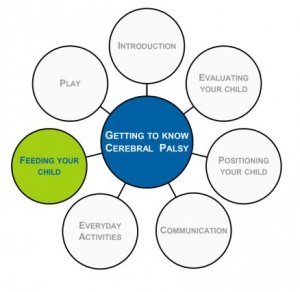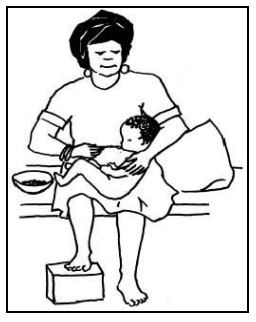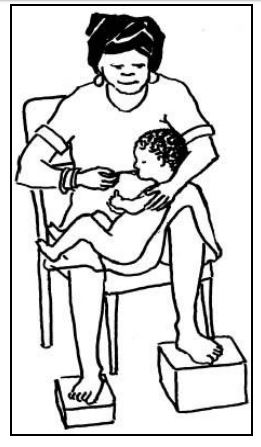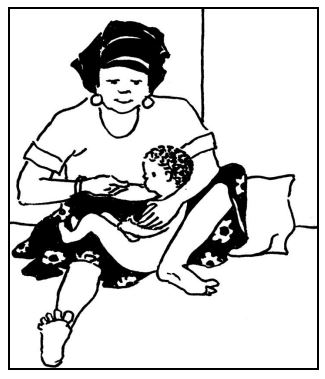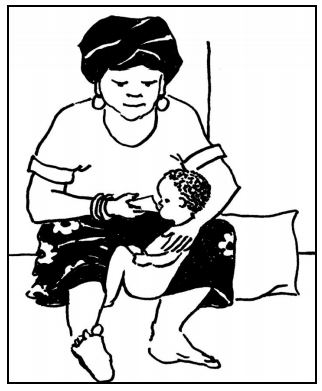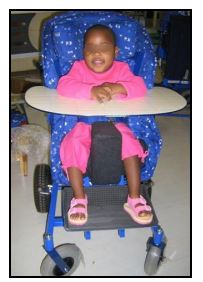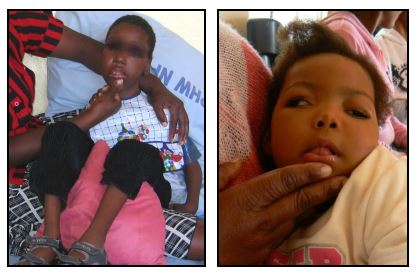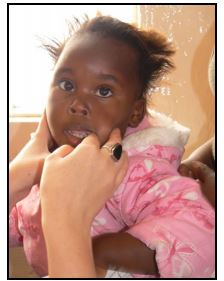Module 6: Feeding Your Child: Difference between revisions
(buggy) |
(chewing) |
||
| Line 1: | Line 1: | ||
== Page Outcomes == | == Page Outcomes == | ||
When you have finished this workshop:[[Image: | When you have finished this workshop:[[Image:Module 6.JPG|border|right|300x300px]] | ||
*You should understand some of the difficulties that a child with cerebral palsy may experience during feeding, and be able to explain these to a family/community member. | *You should understand some of the difficulties that a child with cerebral palsy may experience during feeding, and be able to explain these to a family/community member. | ||
| Line 88: | Line 88: | ||
[[Image:Sitting floor bigger.JPG]] | [[Image:Sitting floor bigger.JPG]] | ||
Extra hints for positioning in this way: | Extra hints for positioning in this way: | ||
*If your child is sinking down too far between your legs, try putting a firm folded towel under her bottom | *If your child is sinking down too far between your legs, try putting a firm folded towel under her bottom | ||
*Make sure her shoulders are really well back and supported. Remember her back must be straight, not rounded | *Make sure her shoulders are really well back and supported. Remember her back must be straight, not rounded | ||
*If her back is still too rounded, slip a folded towel over a piece of board behind her back to give her something to lean against<span style="font-size: 13.28px;"> | *If her back is still too rounded, slip a folded towel over a piece of board behind her back to give her something to lean against<span style="font-size: 13.28px;"> | ||
</span> | </span> | ||
| Line 97: | Line 97: | ||
[[Image:Buggy.JPG|frame]]< | <br> | ||
[[Image:Buggy.JPG|frame]]<br> | |||
<span style="font-size: 13.28px;" /> | <span style="font-size: 13.28px;"> A '''buggy '''like this can give your child all the body support thatshe needs, leaving you free to concentrate on your feeding technique.</span><span style="font-size: 13.28px;">B</span><span style="font-size: 13.28px;">ut make sure she is correctly seated and positioned, as you </span><span style="font-size: 13.28px;">have been shown. </span><span style="font-size: 13.28px;">It’s no good having equipment and then not using it</span><span style="font-size: 13.28px;"> properly. </span><span style="font-size: 13.28px;">Positions for feeding the child on her mothers lap are likely to </span><span style="font-size: 13.28px;">be very difficult with older/bigger children, and are more </span><span style="font-size: 13.28px;">suitable for younger children.</span> | ||
<span style="font-size: 13.28px;"> | <span style="font-size: 13.28px;">For those older / bigger children, use of a proper positioning </span><span style="font-size: 13.28px;">buggy will probably be the only way to achieve a good feeding </span><span style="font-size: 13.28px;">position.</span> | ||
< | <br> | ||
<br> | <br> | ||
< | |||
=== === | |||
=== Helping to swallow === | |||
Other than keeping her in a good position, swallowing can also be improved by helping to close her lips. | |||
*First make sure she is sitting with you in a good position as discussed before. | |||
*Give special attention to the position of her head and neck.The head is upright and straight with the back of her neck long. | |||
*Now place two fingers, one on her chin and one under it. To help close her lips when the food is in her mouth, roll her bottom lip up with your finger to meet her top lip to help her close her mouth. | |||
*The finger under her chin is only there to stabilize your hand, so if you find it difficult to do it like this, you may also use only your thumb or index finger to close the lower lip with a rolling action (as demonstrated in the first two pictures) | |||
*Be careful not to push her head back, but keep it upright with the back of her neck long, especially when she swallows! This position makes it easier for her to swallow and helps to prevent choking. | |||
*At first she may push against your hand, but once she gets used to it, it should help her control the movement of her mouth and tongue. | |||
*<u>Be sure not to push her head backwards</u>, but keep it bent forwardslightly. | |||
*Try to keep your hands in this position for as long as possible during the feed. She will respond better to constant, firm pressure than you putting your hands on and off. | |||
Try this lip closure on yourself first, to get your fingers in the right positions. You may want to try it on someone else in your family before you try it with your child. When you try any new feeding technique with your child, try the new way for 5 – 10 spoonfuls, then go back to your usual way. This is until you and your child get used to the new way. | |||
[[Image:Helping_swallow.JPG]] | |||
=== Spoonfeeding === | |||
*Make sure she is in a good position | |||
*Make sure the food is not too sloppy – it’s easier for your child to deal with a small amount of firm food on the front of the spoon | |||
*Give the spoon from the front, not from above or from the side Keep the spoon flat and press down firmly on her tongue | |||
*Wait for her to close her mouth, or help her to close her lips | |||
*Remove the spoon quickly, keeping it flat. Don’t pull it out against her top teeth | |||
*Maintain the pressure to keep her mouth closed, and let her tongue do it’s job | |||
*Let her enjoy eating and not be afraid of it | |||
=== Chewing === | |||
Babies need to learn to chew to help develop control of the movements of the tongue, cheeks, and lips, which is very important for the development of talking. Lets look at tongue movements as an example: | |||
*When drinking liquids and eating sloppy food the tongue only moves backwards and forwards to suck. This is the way a baby moves her tongue to eat. If an older child still moves her tongue like this to eat, it is because she has never learned to make any other tongue movements. | |||
*When eating solid food the tongue has to move sideways to move the food to the teeth to be chewed, and again to the back of the mouth for swallowing. So the child learns and practices much more control over the movements of her tongue, which will help her when having to control different tongue movements needed for chewing, swallowing and talking. | |||
HINTS TO TEACH HER TO CHEW | |||
*Make sure you are both in a good position to start with Put a small piec[[Image:Chewing.JPG|border|right]]e of solid food such as a little cube of cooked potato or other vegetable between her teeth and the side of her mouth and toward the back. | |||
*Approach with the food from the middle and below so that she doesn’t throw her head back to look at the food. | |||
*Do not push the food into her mouth – pull the corner of her lip out, work your finger gently along her cheek first, and then only slide the food in with your thumb. | |||
*She may need help to keep her mouth closed while she chews. Just roll her bottom lip up gently to help her close her mouth. This will also encourage her to swallow. | |||
*Do not make chewing movements for her. | |||
*Do not try to get her to open and close her mouth as if she were biting. | |||
*Put food in one side, and next time in the other. | |||
*Once you are managing with cooked vegetables, progress to a piece of brown bread. Leave the crust on. Do not use white bread – it causes constipation. | |||
This method of feeding is more helpful than feeding with a spoon. It can get messy but is really a good way to help her learn to chew. It may take a long time initially, but as she gets used to it and better at it, feeding will begin to go more quickly. | |||
Revision as of 12:06, 14 May 2017
Page Outcomes [edit | edit source]
When you have finished this workshop:
- You should understand some of the difficulties that a child with cerebral palsy may experience during feeding, and be able to explain these to a family/community member.
- If your child is not independent in eating then you should be able to work out how to make feeding her easier and more enjoyable for both of you.
- If your child has some independence in eating then you should be able to teach her to eat more independently.
- You should know when to ask for help with feeding your child, if needed.
- You should understand the link between chewing and speech development.
Feeding your child[edit | edit source]
Feeding is one of the first abilities that a child usually develops to meet her needs. But many children with cerebral palsy have feeding difficulties, which can sometimes be severe.
List of feeding difficulties:
- Difficulty controlling her head:
o Her head is floppy and she struggles to keep it upright
o Her head is stiff and pushes backwards
- Difficulty controlling her body
o She cannot sit by herself and struggles to keep her body upright
o It is difficult to hold her body upright when feeding her as she pushes back or
struggles to keep her body still
- Difficulty controlling her mouth/lips/tongue
o She struggles to close her mouth
o She struggles to chew her food
o She struggles to swallow / takes a long time before swallowing her food
o She chokes / coughs a lot when eating
o She pushes the food out of her mouth again with her tongue
o She struggles to eat what other children her age are eating and only eats soft food
- Difficulty eating on her own
o She struggles to hold things and bring them to her mouth
Positions for feeding[edit | edit source]
Remember:
- Be sure your child is in a good position before you begin feeding her!
- The position you use will make feeding either easier and safer, or more difficult and unsafe.
- It is especially important that the head and neck are in a good position for feeding to make swallowing easier and safer.
- You can play with your child in these positions too – that way she gets used to the position before you try feeding her, and you also get comfortable with using these positions.
Checklist for good positions for feeding your child:
- Head and body: Straight and upright; back of the neck must be long
- Shoulders and arms: Forward
- Legs: Hips bent
sitting on a chair, couch, or bed to feed[edit | edit source]
Make sure that you are comfortable, with a cushion behind your back and another under your supporting elbow.
Keep your upper arm firmly against the top of her head, and not behind her neck. Make sure you can see your elbow.
- Hold your child’s bottom firmly between your legs so that she cannot push back.
- Raise your leg that is supporting her knees by putting a box under your foot, and use your other leg to make her back straight.
- Bring her arms forward so that her shoulders also come forward.
If your child’s back is very rounded, it may help if you raise your leg that is behind her back even higher than the other leg.
sitting on the floor to feed[edit | edit source]
- Try to sit in a corner so that you can rest your back and your supporting arm.
- Keep your upper arm firmly against the top of your child’s head – not behind her neck. Make sure you can see your elbow.
- Her shoulders and arms are forward.
- Put a cushion under your raised knee to keep yourself comfortable and to keep her back straight.
- Make sure your child’s bottom is well between your legs so that you can keep her hips firmly bent.
For the bigger child, or for one who pushes back very strongly, try resting her bottom firmly on the floor and then push her legs up towards her chest. Place your leg firmly across her feet to hold them flat on the floor.
Extra hints for positioning in this way:
- If your child is sinking down too far between your legs, try putting a firm folded towel under her bottom
- Make sure her shoulders are really well back and supported. Remember her back must be straight, not rounded
- If her back is still too rounded, slip a folded towel over a piece of board behind her back to give her something to lean against
A buggy like this can give your child all the body support thatshe needs, leaving you free to concentrate on your feeding technique.But make sure she is correctly seated and positioned, as you have been shown. It’s no good having equipment and then not using it properly. Positions for feeding the child on her mothers lap are likely to be very difficult with older/bigger children, and are more suitable for younger children.
For those older / bigger children, use of a proper positioning buggy will probably be the only way to achieve a good feeding position.
[edit | edit source]
Helping to swallow[edit | edit source]
Other than keeping her in a good position, swallowing can also be improved by helping to close her lips.
- First make sure she is sitting with you in a good position as discussed before.
- Give special attention to the position of her head and neck.The head is upright and straight with the back of her neck long.
- Now place two fingers, one on her chin and one under it. To help close her lips when the food is in her mouth, roll her bottom lip up with your finger to meet her top lip to help her close her mouth.
- The finger under her chin is only there to stabilize your hand, so if you find it difficult to do it like this, you may also use only your thumb or index finger to close the lower lip with a rolling action (as demonstrated in the first two pictures)
- Be careful not to push her head back, but keep it upright with the back of her neck long, especially when she swallows! This position makes it easier for her to swallow and helps to prevent choking.
- At first she may push against your hand, but once she gets used to it, it should help her control the movement of her mouth and tongue.
- Be sure not to push her head backwards, but keep it bent forwardslightly.
- Try to keep your hands in this position for as long as possible during the feed. She will respond better to constant, firm pressure than you putting your hands on and off.
Try this lip closure on yourself first, to get your fingers in the right positions. You may want to try it on someone else in your family before you try it with your child. When you try any new feeding technique with your child, try the new way for 5 – 10 spoonfuls, then go back to your usual way. This is until you and your child get used to the new way.
Spoonfeeding[edit | edit source]
- Make sure she is in a good position
- Make sure the food is not too sloppy – it’s easier for your child to deal with a small amount of firm food on the front of the spoon
- Give the spoon from the front, not from above or from the side Keep the spoon flat and press down firmly on her tongue
- Wait for her to close her mouth, or help her to close her lips
- Remove the spoon quickly, keeping it flat. Don’t pull it out against her top teeth
- Maintain the pressure to keep her mouth closed, and let her tongue do it’s job
- Let her enjoy eating and not be afraid of it
Chewing[edit | edit source]
Babies need to learn to chew to help develop control of the movements of the tongue, cheeks, and lips, which is very important for the development of talking. Lets look at tongue movements as an example:
- When drinking liquids and eating sloppy food the tongue only moves backwards and forwards to suck. This is the way a baby moves her tongue to eat. If an older child still moves her tongue like this to eat, it is because she has never learned to make any other tongue movements.
- When eating solid food the tongue has to move sideways to move the food to the teeth to be chewed, and again to the back of the mouth for swallowing. So the child learns and practices much more control over the movements of her tongue, which will help her when having to control different tongue movements needed for chewing, swallowing and talking.
HINTS TO TEACH HER TO CHEW
- Make sure you are both in a good position to start with Put a small piece of solid food such as a little cube of cooked potato or other vegetable between her teeth and the side of her mouth and toward the back.
- Approach with the food from the middle and below so that she doesn’t throw her head back to look at the food.
- Do not push the food into her mouth – pull the corner of her lip out, work your finger gently along her cheek first, and then only slide the food in with your thumb.
- She may need help to keep her mouth closed while she chews. Just roll her bottom lip up gently to help her close her mouth. This will also encourage her to swallow.
- Do not make chewing movements for her.
- Do not try to get her to open and close her mouth as if she were biting.
- Put food in one side, and next time in the other.
- Once you are managing with cooked vegetables, progress to a piece of brown bread. Leave the crust on. Do not use white bread – it causes constipation.
This method of feeding is more helpful than feeding with a spoon. It can get messy but is really a good way to help her learn to chew. It may take a long time initially, but as she gets used to it and better at it, feeding will begin to go more quickly.
